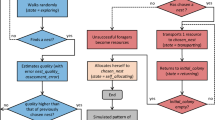A colony of social insects is an excellent model for investigating the organization of responses of subunits (i.e. colony members) with limited skills into sophisticated collective behavior. The defence system of Lasius niger ant colonies is well organized in a context-dependent way. The proportion of fighting ants to fleeing ants changes gradually according to the importance of the area being defended, and was higher where ants tended honeydew-rich aphids and on trails for foraging with heavy traffic, than where ants were walking alone or on trails with light traffic. Although there were intrinsic differences in aggressiveness between individual ants, the differences in aggressive responses between defended areas was not due to the presence of highly aggressive or timid individuals in each area. Instead, it was due to a change in aggressiveness of individuals in response to external conditions. The cue that altered individual aggressiveness was the presence of surrounding nest-mates, rather than the presence of aphids. We concluded that the defence system of this ant species consists of three processes: (i) a recruiting system that allocates more workers to more valuable resources; (ii) individual ants following a simple decision rule to become more aggressive in response to increased numbers of nest-mates nearby (hence aggressive behavior reflecting the importance of each area to the colony); and (iii) variability in individual responses causing a gradual change in the proportion of fighting ants responding to a threat.
Similar content being viewed by others
REFERENCES
Beckers R., Deneubourg J. L., Goss S. (1992) Trail laying behaviour during food recruitment in the ant Lasius niger (L.). Insectes Sociaux 39: 59–72.
Beckers R., Deneubourg J. L., Goss S. (1993) Modulation of trail laying in the ant Lasius niger (Hymenoptera: Formicidae) and its role in the collective selection of a food source. Journal of Insect Behavior 6: 751–759.
Beckers R., Deneubourg J. L., Goss S., Pasteels J. M. (1990) Collective decision making through food recruitment. Insectes Sociaux 37: 258–267.
Beshers S. N., Robinson G. E., Mittenthal J. E. (1999) Response thresholds and division of labor in insect colonies. In: Information Processing in Social Insects (eds C. Detrain, J. L. Deneubourg & J. M. Pasteels) pp. 115–139. Birkhauser Verlag, Basel.
Bonabeau E. & Theraulaz G. (1999) Role and variability of response thresholds in the reguration of devision of labor in insect societies. In: Information Processing in Social Insects (eds C. Detrain, J. L. Deneubourg & J. M. Pasteels) pp. 141–163. Birkhauser Verlag, Basel.
Bonseries B., Wright P. J., Bament S., Chukwu U. O. (1998) Optimal patch use by foraging workers of Lasius fuliginosus, L. niger and Myrmica ruginodis. Ecological Entmology 23: 15–21.
Brown M. J. F. & Gordon D. M. (1997) Individual specialisation and encounters between harvester ant colonies. Behaviour 134: 849–866.
Davies N. B. & Houston A. I. (1984) Territory economics. In: Behavioural Ecology: an Evolutionary Approach, 2nd edn (eds J. R. Krebs & N. B. Davies) pp. 148–169. Sinauer Associates, Sunderland.
Detrain C., Deneubourg J. L., Pasteels J. M. (1999) Information Processing in Social Insects. Birkhauser Verlag, Basel.
Detrain C. & Pasteels J. M. (1992) Caste polyethism and collective defense in the ant, Pheidole pallidula: The outcome of quantitative differences in recruitment. Behavioral Ecology and Sociobiology 29: 405–412.
Franks N. R. & Partridge L. W. (1993) Lanchester battles and the evolution of combat in ants. Animal Behaviour 45: 197–199.
Gordon D. M. (1987) Group-level dynamics in harvester ants: young colonies and role of patrolling. Animal Behaviour 35: 833–843.
Gordon D. M. (1989) Dynamics of task switching in harvester ants. Animal Behaviour 38: 194–204.
Gordon D. M. (1996) The organization of work in social insect colonies. Nature 380: 121–124.
Hasegawa E. (1993) Nest defense and early production of the major workers in the dimorphic ant Colobopsis nipponicus (Wheeler) (Hymenoptera: Formicidae). Behavioral Ecology and Sociobiology 33: 73–77.
Hölldobler B. & Wilson E. O. (1977) Colony-specific territorial pheromon in the African weaver ant Oecophylla longinoda (Latreille). Proceeding of the National Academy of Sciences of the United States of America 74: 2072–2075.
Hölldobler B. & Wilson E. O. (1990) The Ants. Belknap Press, Cambridge.
Mayade S., Cammaerts M. C., Suzzoni J. P. (1993) Home-range marking and territorial marking in Cataglyphis cursor (Hymenoptera, Formicidae). Behavioural Processes 30: 131–142.
Oster G. F. & Wilson E. O. (1978) Cast and Ecology in the Social Insects. Princeton University Press, Princeton.
Robinson G. E. (1992) Reguration of division of labor in social insect colonies. Annual Review of Entomology 37: 637–665.
Sakata H. (1995) Density-dependent predation of the ant Lasius niger (Hymenoptera: Formicidae) on two attended aphids Lachnus tropicalis and Myzocallis kuricola (Homoptera: Aphididae). Researches on Population Ecology 37: 159–164.
Salzemann A. & Jaffe K. (1990) On the territorial behavior of field colonies of the leaf-cutting ant Atta laevigata (Hymenoptera: Myrmicinae). Journal of Insect Physiology 36: 133–138.
Salzemann A., Nagnan P., Tellier F., Jaffe K. (1992) Leaf-cutting ant Atta laevigata (Formicidae: Attini) marks its territory with colony-specific Dufour gland secretion. Journal of Chemical Ecology 18: 183–196.
sas institute inc. (1996) SAS/STAT Software Changes and Enhancements. SAS Institute, Cary, NC, USA.
Seeley T. D. (1982) Adaptive significance of the age polyethism schedule in honeybee colonies. Behavioral Ecology and Sociobiology 11: 287–293.
Seeley T. D. (1996) The Wisdom of the Hive: the Social Physiology of Honey Bee Colonies. Belknap Press, Cambridge.
Tschinkel W. R., Adams E. S., Macom T. (1995) Territory area and colony size in the fire ant Solenopsis invicta. Journal of Animal Ecology 64: 473–480.
Wilson E. O. (1976a) Behavioral diacretization and the number of castes in an ant species. Behavioral Ecology and Sociobiology 1: 141– 154.
Wilson E. O. (1976b) A social ethogram of the neotropical arboreal ant Zacryptocerus varianus (Fr. Smith). Animal Behavior 34: 354–363.
Author information
Authors and Affiliations
Corresponding author
About this article
Cite this article
Sakata, H., Katayama, N. Ant defence system: A mechanism organizing individual responses into efficient collective behavior. Ecol Res 16, 395–403 (2001). https://doi.org/10.1046/j.1440-1703.2001.00404.x
Received:
Accepted:
Issue Date:
DOI: https://doi.org/10.1046/j.1440-1703.2001.00404.x




